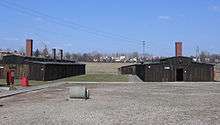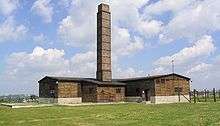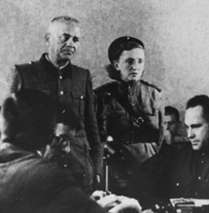Anton Thernes
| Anton Thernes | |
|---|---|
|
Former SS-Obersturmführer Anton Thernes in front of a penal court on trial for crimes he committed at Majdanek (standing left), 1944 | |
| Born | 8 February 1892 |
| Died |
3 December 1944 (aged 52) Military career |
| Allegiance |
|
| Service/branch |
|
| Years of service | until 1945 |
| Rank | Obersturmführer |
| Unit | SS-Totenkopfverbände |
SS-Obersturmführer Anton Thernes (8 February 1892 – 3 December 1944) was a Nazi German war criminal, deputy commandant of administration at the notorious Majdanek concentration camp on the outskirts of Lublin, Poland in World War II.[1][2][3] He was tried at the Majdanek Trials and executed on 3 December 1944 along with five other war criminals near the gas chambers and the Majdanek crematorium.[2][4]
War crimes
Thernes was married with six children in Trier before the Nazi German invasion of Poland.[5] A member of the SS, Thernes served as the last administrative chief of KL Lublin / Majdanek. He was also in charge of food and slave labour administration, starvation rationing, and the maintenance of camp structures including the storage depot for property and valuables stolen from the Holocaust victims at the killing centers in Belzec, Sobibor, and Treblinka.[6]


Thernes was given the task of destroying the evidence of crimes against humanity and genocide, but ran out of time due to his ineptitude and lethargy.[5] Instead of blowing up the chimneys and torching his city of death, the SS actually brought an additional 500 prisoners from Lublin for the last timely kill, while the T-34 tanks were already at the gates.[5] Thernes was caught by the Soviets and tried at the Majdanek Trials together with his assistant SS-Hauptsturmführer Wilhelm Gerstenmeier. He denied knowing anything, but the proceedings were swamped with testimonial proofs offered by eyewitnesses.[5] He was executed on 3 December 1944 along with five other war criminals, close to the gas chambers and the Majdanek crematorium.[2][4]
Harvest Festival
During the mere 34 months of camp operation, more than 79,000 people were murdered at the main camp alone (59,000 of them Polish Jews).[7] Some 18,000 Jews were killed at Majdanek on 3 November 1943 during the largest single-day, single-camp massacre of the Holocaust,[8] named Harvest Festival (totalling 43,000 with subcamps).[9]
Notes
- ↑ Jean-michel Frodon (2010). "Majdanek Trial". Cinema and the Shoah. SUNY Press. pp. 249–. ISBN 1438430280. Retrieved 2013-04-13.
- 1 2 3 "Majdanek Concentration Camp". Majdanek, Poland. July 21, 2009. Retrieved 2013-04-13.
- ↑ Marcus Wendel (Aug 8, 2007). "SS personnel serving at Majdanek". Camp personnel. Axis History. Retrieved April 14, 2013.
- 1 2 "Procesy zbrodniarzy (Trials of war criminals) 1946–1948". Wykaz sądzonych członków załogi KL Lublin/Majdanek. KL Lublin. Retrieved 2013-04-14.
- 1 2 3 4 Narration (2013). "Anton Thernes answers questions at the Majdanek Trials. Historical film footage". Majdanek concentration camp. Part 2 of 5. Google+: real life sharing (from Official archives of the Republic of Poland). Retrieved 2013-04-22.
- ↑ Staff Writer (2006), "Lublin/Majdanek Concentration Camp: Overview", United States Holocaust Memorial Museum, ushmm.org.
- ↑ Reszka, Paweł (2005-12-23). "Majdanek Victims Enumerated. Changes in the history textbooks?". Gazeta Wyborcza. Auschwitz-Birkenau State Museum. Retrieved 2010-04-13.
- ↑ USHMM (May 11, 2012). "Soviet forces liberate Majdanek". Lublin/Majdanek: Chronology. United States Holocaust Memorial Museum, Washington, DC. Retrieved 2013-04-13.
- ↑ Jennifer Rosenberg. "Aktion Erntefest". 20th Century History. About.com Education. Retrieved 2013-04-16.
